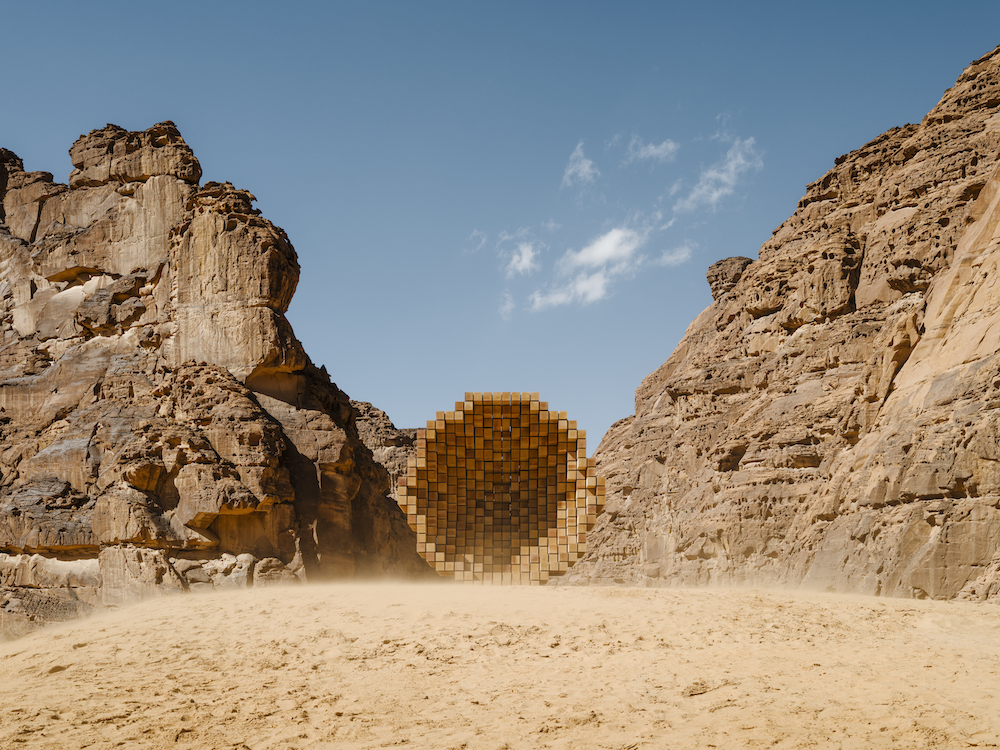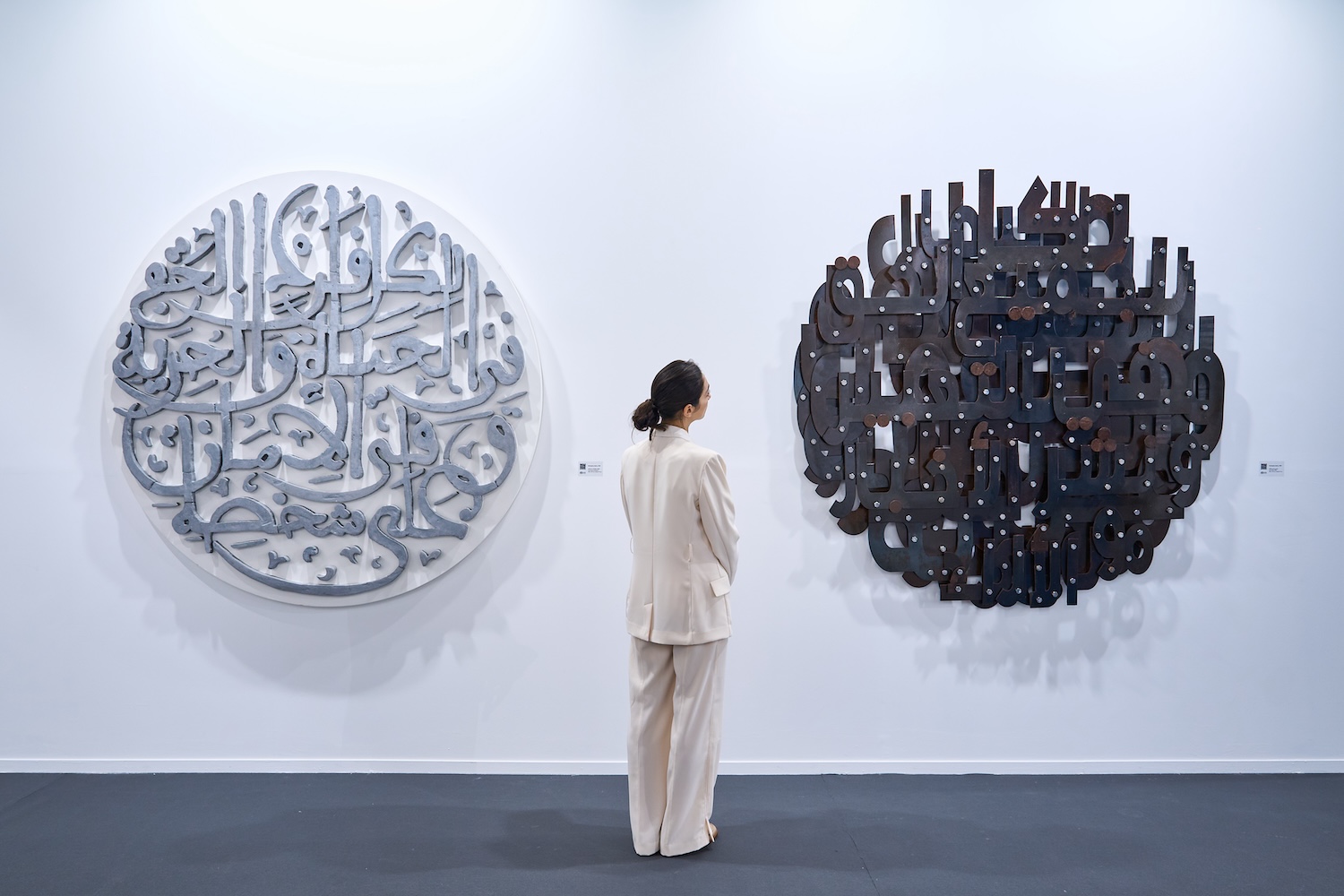Currently on view at Desert X AlUla is the interactive sculpture, Where The Dwellers Lay, by Saudi-Palestinian artist Dana Awartani. Part of an open-air exhibition in the desert, Awartani’s culturally and physically complex structure both disappears into the natural rocky landscape like a hypnotic mirage and emerges as a man-made tour de force—mediating an important dialogue between the land and its inhabitants.
The laborious sculpture uses thousands of Saudi stones and is inspired by the local “rock-cut” ancient Nabataean tombs and their intricate design work. Awartani, an adept practitioner, is well-versed in patiently using traditional methods to create bold multidisciplinary artworks for the contemporary moment.
Stepping into uncharted territory in scale, material, and location, Awartani stayed true to her roots for this public project. Her pieces begin with themes inherent in Islamic geometry—symmetry, harmony, and infinite structural forms—giving the works both implicit beauty and sustained meaning. Whitewall was fortunate enough to sit down with the prolific artist to learn more about her faithful approach to honoring the vibrant desert.
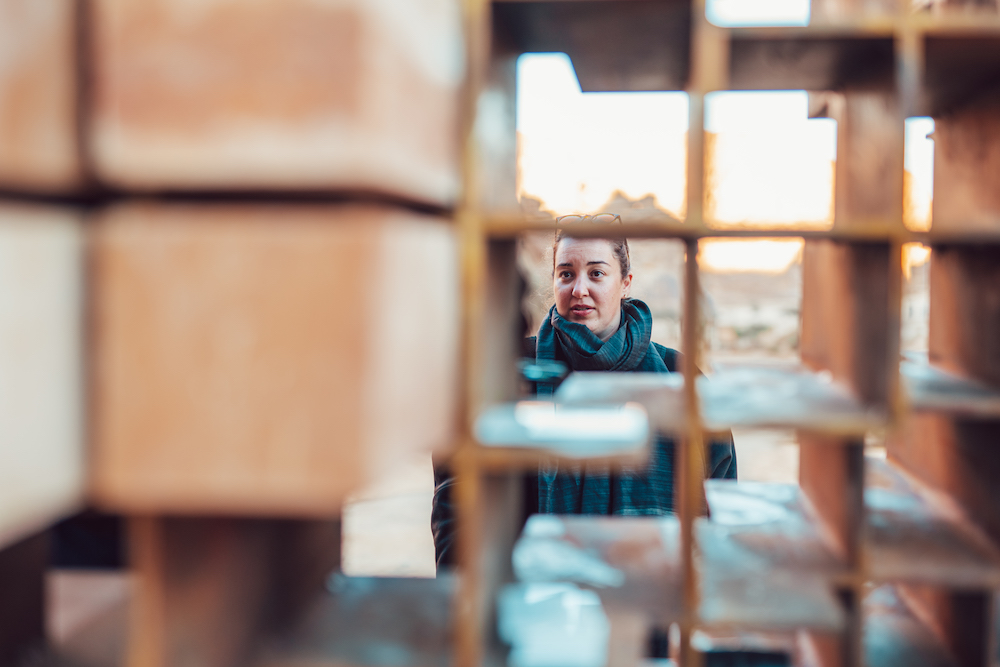
Dana Awartani, courtesy Desert X AlUla.
WHITEWALL: Can you tell us about your practice and how this project began for you?
DANA AWARTANI: I am an artist based in Jeddah, Saudi Arabia. My art in general looks at the intersection between the traditional and the contemporary. I trained both at Central Saint Martins where I got a very contemporary way of looking at art—how to conceptualize artworks, how to research—and then I went on to the Prince’s School of Traditional Arts in London, which was the complete opposite. It was all about making and really steeped in the history of traditional craft. I always loved the two but I felt there was a divide between the handmade craft and the contemporary arts. I try to bridge that in my work. Every artwork I do is a way to revive historical modes of making that are dying, talk about heritage that’s in danger of dying, cultural destruction in general. Everything pays homage to the handmade, the natural material.
When I came to AlUla, the site visit completely dictated the work I was making. My first impression of AlUla is that it is so overwhelmingly beautiful. It’s not a place that is a white gallery space. You have to create an artwork that is respectful, that blends, and feels like it belongs here. I feel if you try to compete with the environment it’s a losing battle.
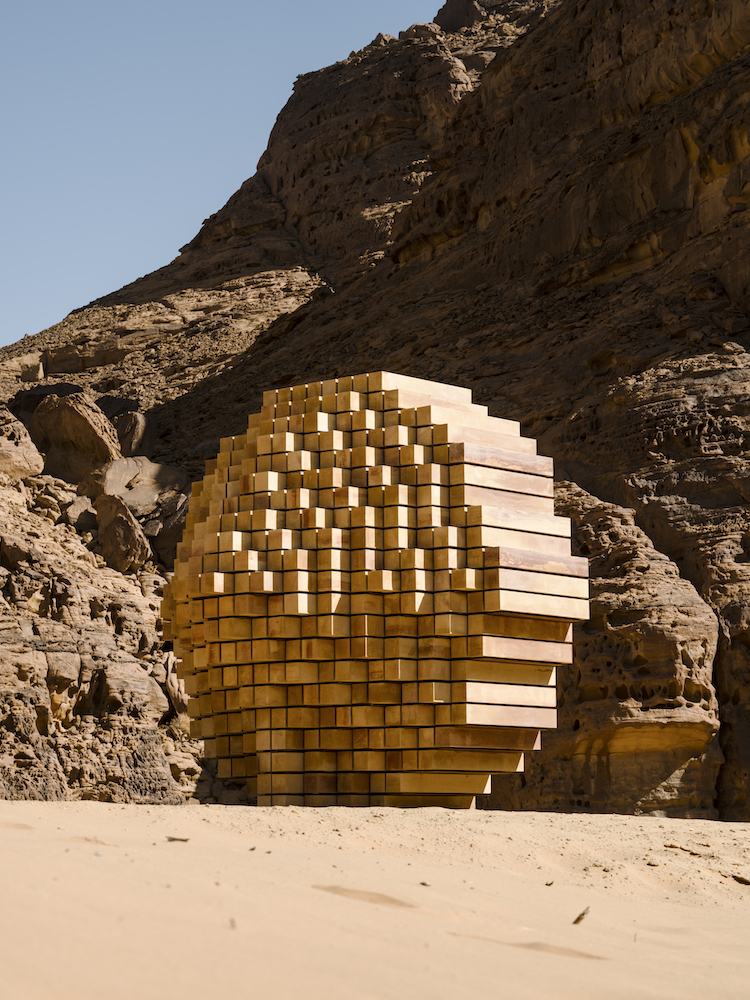
Dana Awartani Desert X AlUla 2022, photo by Lance Gerber.
I was specifically inspired by the old tombs of Mada’in Saleh. They have this stepwell design at the top, the staircase design on the big tombs. They’re supposed to represent the ascension from earth to heaven—it’s a staircase to heaven. I found that design simple but beautiful. So the whole pattern of my sculpture is generated from that.
If you look, it’s a 10pointed polygon. The whole is the step design, and it’s a concave version of that. I contemporize the traditional pattern. I wanted it to be an interactive artwork that had a function.I felt when you walk from one space to another you’re trekking the desert, it’s a space of reflection and contemplation. It’s up on the dune where, when you sit, what you see is the whole canyon. It’s in a quieter space on its own. So that’s the title of it, Where The Dwellers Lay. It references the dwellers because AlUla was on a trade route. It plays on the idea of the tombs where you lay someone to rest but it’s also a place where you can lay and relax.
WW: How did that inspire the material??
DA: I wanted to work with a local material from Saudi Arabia, so it belongs here. If it stays, in a few thousand years it will look the same as the rock face and camouflage into the landscape.
It pays homage to the local architecture they built with the stone. I wanted to repurpose a contemporary way of using stone as well in a structural way. It is rooted in my practice in general, always working with natural materials.
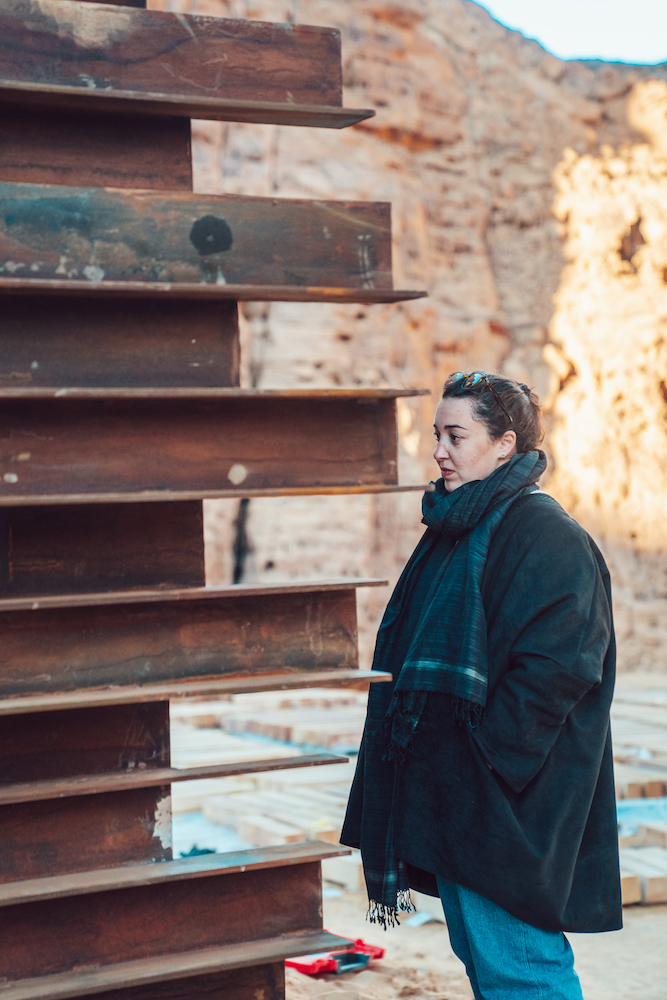
Dana Awartani, courtesy Desert X AlUla.
WW: How should visitors interact with this piece?
DA: I think it’s really personal. Seeing it from the back is a very different experience from seeing it in the front. You can interact with it by going inside it, being immersed in it. The stone has a cooling effect, it absorbs the heat and becomes cold on the inside.
WW: Did you explore anything new with this project?
DA: This is completely new. Working on this scale, with an interactive work where you can go inside. The material is new for me. The whole thing.
WW: What aspect of the project will you take back with you to the studio?
DA: I’m still processing everything. I love all of it from the way it was made, with the material I used, to the design of it. There are infinite possibilities of design when it comes to design with geometry.
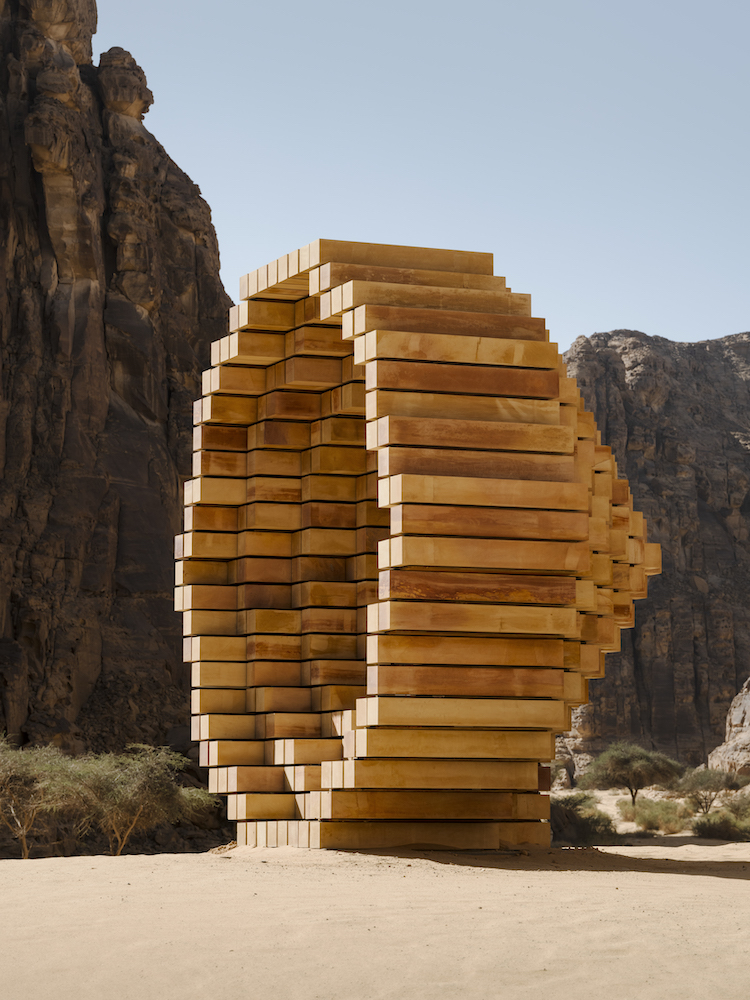
Dana Awartani Desert X AlUla 2022, photo by Lance Gerber.
WW: You recently had work on view in the Diriyah Biennial. Can you tell us about that??
DA: The work I had there was called Standing Amongst the Ruins of Aleppo. I come from quite a mixed heritage background: I’m Saudi, I’m Palestinian, I’m Syrian, and I’m Jordanian. So my work is never usually just inspired by one place. If you look at the history of my work it’s generally about the Arab region as a whole because I am an Arab as a whole.
This was really paying homage to the matrilineal lineage of my family—my grandmother who is from Syria. Usually, you take on your father’s identity, you take your father’s second name, your father’s nationality. I wanted to focus on my mother and my grandmother. The food we eat at home is Syrian, my mother speaks Syrian, and that I feel is forgotten.
More importantly, the work focuses on the Grand Mosque of Aleppo which was heavily destroyed during the Arab Spring. It was a stronghold for the anti-government protests. With the war going on it was heavily damaged. It’s a UNESCO world heritage site so the minaret, which dates back centuries, is completely gone. The work I did was a recreation of the courtyard of that mosque but I made them out of clay earth, adobe bricks, which pays homage to Diriyah’s architectural heritage because Diriyah is built with mud houses as well. Also, I share the history of violence because when the Ottomans invaded Dirayah they burnt the whole city to the ground. It’s made out of like 13,000 bricks by hand that come together in this mosaic of the floor.
WW: How did you create all of this? Did you have a big team?
DA: It was a long process for production. From design, I couldn’t find online architectural drawings of the floor or an image of the whole design, so I had to recreate the design by archiving images. I redrew the design, the floor, exactly how it was, which alone took two, three months. Then to translate that into a way that it could be broken down into bricks. There were 13,000 bricks we had to make by hand. That was another two-month process.
It was quite a beautiful form of production. I would be on site from sunrise until sunset because you need the sun for the bricks to dry. That’s how adobe bricks are made, they dry, and then I remove it from a mold and then re-pour the clay inside it. It was a very repetitive but therapeutic process, very labor-intensive. It was me and 10 other people.
The production of my work sometimes is more important than the end result because the production takes forever. In this one there are 400 hand-cut stones. It is physical labor in the sun. And it’s the Saudi sun which is really intensive. But I loved it because working with my hands is what I enjoy. I worked with three different clays for the different colors—they all shrink at different rates and this is something you can’t control when you work with a natural material. There are all of these challenges and I had to figure out solutions.
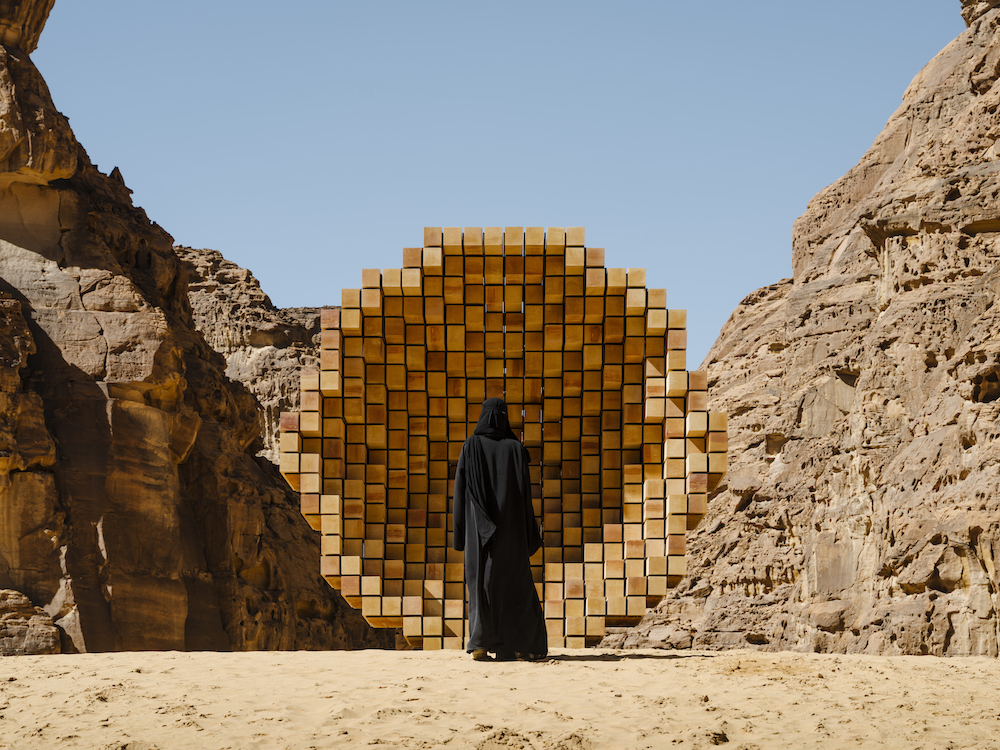
Dana Awartani Desert X AlUla 2022, photo by Lance Gerber.



